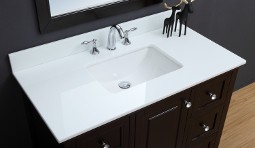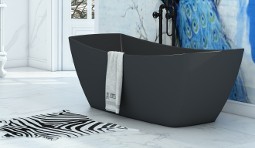
It’s easy to overlook a mirror. After all, when we glance in one, we see a reflection of so many other things before we see the mirror itself. But a good mirror is an essential component of many rooms, especially the bathroom. There are many sizes, styles and shapes to choose from, so before you buy, read this guide to help you get your bathroom mirror just right.
Sizing your mirror
When choosing the size of your mirror, you should consider not just function, but also proportion. To create a balanced look, think about the size of your mirror in relation to your vanity unit.
Typically, a mirror shouldn’t be wider than the vanity unit itself, with some exceptions discussed later in this story.
A common approach is to have a mirror that’s exactly as wide as the unit, so the two line up perfectly. Of course, this is much easier with a custom mirror, because it might be tricky to find an off-the-peg design in the perfect size.
If they’re not the same width, another approach is to make the mirror about 70 to 80% as wide as the vanity unit, so it appears a bit smaller, but not shrunken.
With respect to height, a functional mirror need only reach about a foot above and below the eyeline of the people who’ll be using it. However, the more height you can get, the better, because it will provide more viewing angles and give the space a more open look. Try to span at least 4 to 7ft (1.2 to 2m) above the floor.
Single vs multiple
If you have a wide vanity unit, especially one with multiple basins, you have the option of using multiple mirrors or one single mirror wide enough to service both.
Using several tall, skinny mirrors can give a room a more vertical look, emphasising the height of the space (especially effective if you have a high ceiling). Of course, using a single large mirror opens up the room by reflecting more of the opposite walls. Ultimately, the choice comes down to personal preference.
Using multiple mirrors can still work even when there’s only one basin.
In fact, centring a mirror on the basin and then adding a second mirror symmetrical to the first can make the whole composition look more pleasingly balanced, compared with using just a single mirror.
Mirror-side wall lights
Another reason to use smaller mirrors is to allow some room for wall lights to sit in-between. Light for a vanity unit can be located in various spots, but placing it to the sides of the mirror lights the face well, so it’s both beautiful and functional.
When leaving room for wall lights, choose a mirror that’s closer to 60 to 70% of the width of the vanity unit (divided by the number of mirrors, if you have more than one), so the lights have room to sit above the unit, rather than hanging beyond the edges.
Wall-to-wall mirrors
For a different approach to sizing your mirror, you can ignore the size of the vanity unit on its own and instead use the mirror to fill the whole wall. This will give you a larger mirror, which can go a long way towards making a compact bathroom feel twice the size.
You can run the mirror literally wall-to-wall (and typically up to the ceiling) or extend it from one end of the vanity unit to the end of a nearby fixture.
In the latter case, though, it should still fill most of the wall to avoid looking as if it’s simply the wrong size – and it should line up neatly with the objects below.
On one hand, having a custom mirror cut to fit perfectly wall-to-wall is more costly than buying off-the-shelf. On the other hand, compared with running tiles or stone behind or around a smaller mirror, it’s often a relatively budget-friendly choice.
Depending on your budget and goals, it may make sense to use a custom mirror paired with a little splash of a splurge material like marble.
Framed vs frameless
Frameless mirrors are a popular choice in bathrooms for several reasons. One is that they tend to be less expensive while often still stylish. A second is that they give modern appeal, and even bathrooms in traditional homes tend to the more modern to achieve a clean, spa-like look.
Frameless mirrors work most easily in contemporary or modern and minimalist spaces without a lot of busy décor. Mirrors with elaborate frames tend to suit traditional spaces, where the other elements are also very detailed and decorative.
For a nice balance that can suit nearly any space, try a mirror with a simple frame that’s a few centimetres wide and in a textural material that isn’t too busy.
If eclectic is more your style, an ornate mirror can look magnificent as a statement piece in a modern bathroom.
Getting the mix just right will take a good design eye, but the unique result will bring a lot of personality and drama to the room.
Inset mirrors
A clever way to get the modern look of a frameless mirror and the sense of polish of a framed design is to inset the mirror into tiles, so it’s essentially framed by the surrounding material.
Round mirrors
I’ve mostly looked at simple, rectangular mirrors so far, but of course there are many other shapes.
Round mirrors can be a great way to bring some softness and relaxed appeal to a bathroom, which often has a lot of hard surfaces and crisp lines.
Round mirrors are a great companion to pedestal basins, as these often have curved lines themselves.
Circular designs leave more negative space at the ‘corners’ than rectangular mirrors, so they work nicely with pedestal basins, which have negative space around the base.
A round mirror is also a great choice if you have an interesting wall finish to show off. It gives you enough mirror in which to see your face, but leaves a bit more wall exposed, and the curved lines will pick up the organic shapes in a leafy or floral print.
Medicine cabinets
OK, all of the previous mirrors were attractive, but what if you need some serious storage space?
Mirrored medicine cabinets are best when inset into the wall – that way they won’t be so in-your-face. A professional can guide you as to whether your wall cavity can house some inset or partially inset cabinets.
Otherwise, try using a few tricks to avoid letting the cabinet visually shrink the room. A design with little or no frame will be less dominating, while adding some under-cabinet lighting (just as you might in a kitchen) will bring a glow that cancels out any dark shadows and makes the whole basin area feel more open.
Suspended mirrors
If you have an unusual bathroom layout or an inconveniently placed window or obstacle, don’t forget that mirrors don’t have to hang flat on a wall.
Suspending a mirror from the ceiling or a window frame can allow you to place it in a new, functional spot.
Source: https://www.houzz.co.uk/ideabooks/102183923/list/how-to-choose-a-bathroom-mirror

































